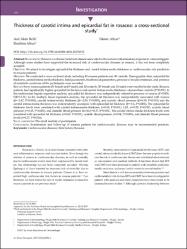| dc.contributor.author | Belli, Aslı Akın | |
| dc.contributor.author | Altun, İlknur | |
| dc.contributor.author | Altun, İbrahim | |
| dc.date.accessioned | 2020-11-20T14:51:41Z | |
| dc.date.available | 2020-11-20T14:51:41Z | |
| dc.date.issued | 2017 | |
| dc.identifier.issn | 0365-0596 | |
| dc.identifier.issn | 1806-4841 | |
| dc.identifier.uri | https://doi.org/10.1590/abd1806-4841.20176832 | |
| dc.identifier.uri | https://hdl.handle.net/20.500.12809/1792 | |
| dc.description | WOS: 000422863200011 | en_US |
| dc.description | PubMed ID: 29364439 | en_US |
| dc.description.abstract | Background: Rosacea is a chronic facial skin disease associated with excessive inflammatory response to various triggers. Although some studies have supported the increased risk of cardiovascular diseases in rosacea, it has not been completely accepted. Objective: We aimed to investigate epicardial fat thickness and carotid intima-media thickness as cardiovascular risk predictors in rosacea patients. Methods: We conducted a cross-sectional study including 40 rosacea patients and 40 controls. Demographic data, epicardial fat thickness, carotid intima-media thickness, lipid parameters, biochemical parameters, presence of insulin resistance, and presence of metabolic syndrome of the participants were recorded. Results: Forty rosacea patients (31 female and 9 male) and 40 controls (30 female and 10 male) were enrolled in the study. Rosacea patients had significantly higher epicardial fat thickness and carotid intima-media thickness volumes than controls (P<0.001). In the multivariate logistic regression analysis, epicardial fat thickness was independently related to presence of rosacea (P<0.001, OR=13.31). In the multiple linear regression analysis, the epicardial fat thickness was independently associated with rosacea (beta=0.47, P<0.001), carotid intima-media thickness (beta=0.36, P<0.001), and systolic blood pressure (beta=0.19, P=0.015) and the carotid intima-media thickness was independently associated with epicardial fat thickness (beta=0.6, P<0.001). The epicardial fat thickness levels were correlated with carotid intima-media thickness (r=0.63, P<0.001), LDL (r=0.23, P=0.037), systolic blood pressure (r=0.45, P<0.001), and diastolic blood pressure levels (r=0.37, P=0.001). The carotid intima-media thickness levels were correlated with epicardial fat thickness (r=0.63, P<0.001), systolic blood pressure (r=0.04, P<0.001), and diastolic blood pressure levels (r=0.27, P=0.016). Study limitations: The small number of participants. Conclusions: Examination and follow-up of rosacea patients for cardiovascular diseases may be recommended practices. | en_US |
| dc.item-language.iso | eng | en_US |
| dc.publisher | Soc Brasileira Dermatologia | en_US |
| dc.item-rights | info:eu-repo/semantics/openAccess | en_US |
| dc.subject | Cardiovascular Diseases | en_US |
| dc.subject | Risk Factors | en_US |
| dc.subject | Rosacea | en_US |
| dc.title | Thickness of carotid intima and epicardial fat in rosacea: a cross-sectional study | en_US |
| dc.item-type | article | en_US |
| dc.contributor.department | MÜ, Eğitim ve Araştırma Hastanesi | en_US |
| dc.contributor.institutionauthor | Belli, Aslı Akın | |
| dc.contributor.institutionauthor | Altun, İlknur | |
| dc.contributor.institutionauthor | Altun, İbrahim | |
| dc.identifier.doi | 10.1590/abd1806-4841.20176832 | |
| dc.identifier.volume | 92 | en_US |
| dc.identifier.issue | 6 | en_US |
| dc.identifier.startpage | 820 | en_US |
| dc.identifier.endpage | 825 | en_US |
| dc.relation.journal | Anais Brasileiros de Dermatologia | en_US |
| dc.relation.publicationcategory | Makale - Uluslararası Hakemli Dergi - Kurum Öğretim Elemanı | en_US |


















